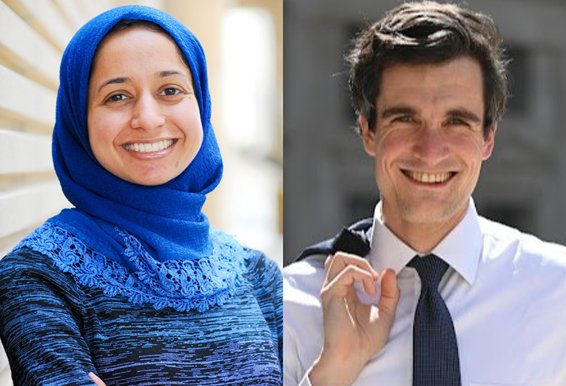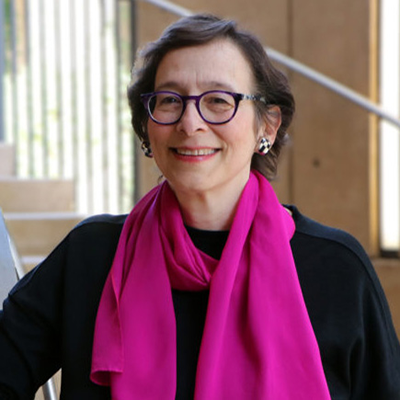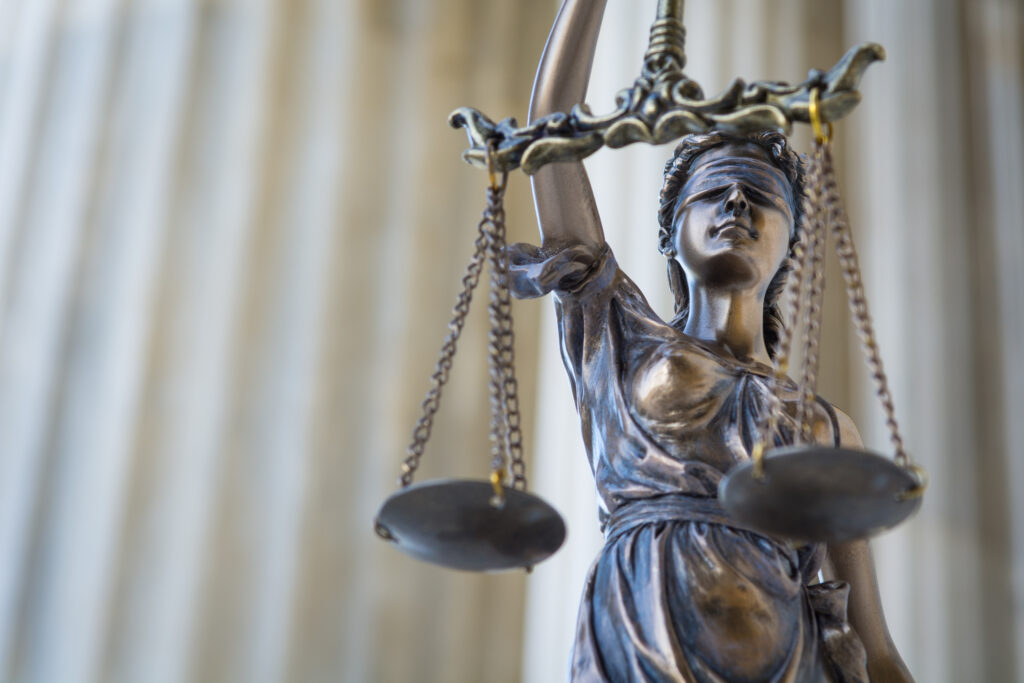Political Violence, Hate Groups, and the Rule of Law: A Discussion with Stanford Law’s Shirin Sinnar and Former DOJ Prosecutor Brendan Ballou
In one of his first official acts, President Trump issued a sweeping grant of pardons and commutations to the approximately 1,600 people who stormed the Capitol on January 6, 2021. According to the guests on a recent episode of the Stanford Legal podcast, the fallout will be far-reaching and dangerous.

Shirin Sinnar, William W. and Gertrude H. Saunders Professor of Law, and former Department of Justice prosecutor Brendan Ballou, JD ’16, joined podcast co-host Pamela Karlan for a wide-ranging discussion about a “whirlwind week of executive action” and what is to come. Ballou, who was involved in prosecuting some of the January 6 defendants, recently wrote a New York Times op-ed titled “I Prosecuted the Capitol Rioters, They Have Never Been More Dangerous.” He resigned from the DOJ on January 23.
The following is an shortened and edited version of the full podcast transcript, which can be found here.
Pam Karlan: Brendan, can you tell us about your experiences doing prosecutions of these folks? What kinds of things were they alleged actually to have done?
Brendan Ballou: I was a very small part of a very large effort. When people more central to this story leave the government, I hope that they will tell their stories. The statutes used to prosecute the Capitol rioters were quite ordinary ones because, while in the aggregate, the attack on the Capitol was enormous and essentially unprecedented, the individual crimes themselves were quite straightforward.
On January 6, 2021, a restricted perimeter had been established around the Capitol to make clear that people weren’t allowed in, not just because the election was being certified, but as you may remember, the COVID pandemic was still raging. This perimeter was made clear with bike racks, snow fencing, signs, and police officers. And if someone trespassed onto that restricted perimeter knowingly, they were charged with a cluster of misdemeanors, primarily under 18 USC 1752, which prohibits trespass and disorderly conduct on restricted building or buildings or grounds.
For most of the people that attacked the Capitol, those were the table stakes. Things then progressed along a spectrum depending on what their conduct was. If they assaulted a federal office, we have 18 USC 111 under which they would typically be charged. If they stole or destroyed property, they might be charged with 18 USC 1361 or 664. And there was a broader range of conduct, things that maybe wouldn’t necessarily fit the exact definition of assault because they didn’t touch an officer or somebody in the Capitol, but nevertheless they were involved in violent conduct. Oftentimes, they were charged with what we would call civil disorder, 18 USC 231.
Pam Karlan: There’s something striking about the fact that these were ordinary crimes and if they had simply been committed by a random person, there would be no controversy about prosecuting them. If somebody had gone up to the Capitol on any other day and had socked a police officer and tried to grab the police officer’s billy club, of course, they would have been prosecuted, right?
Brendan Ballou: Absolutely. I think this gets to a broader point, both about the prosecutions and about the pardons. And I’m sure Professor Shirin Sinnar will have comments on this, which is, I think this is a very standard playbook in illiberal democracies or illiberal agendas in that they often need to rewrite their violent creation history. You see this happening in Brazil where Bolsonaro is now trying to rewrite the history of that country’s military dictatorship. You see that in Russia where Putin’s government is trying to essentially re-convict dissidents during the Soviet era who were acquitted in the 1990s. We’re at a point where a great many politicians’ careers, in some sense, depend on rewriting the history of January 6th.
When people see the videos from that day–and I saw this happen personally when I watched jurors see videos in trials–it’s really hard to refute the reality of what happened at the Capitol. So, I think the challenge for the coming years will be to find ways to keep the memory of that event and the truth of that event alive and prevent it from being rewritten.
Shirin Sinnar: For some groups, there was a very concerted effort to bring people to the Capitol armed in order to assault the institutions to prevent the certification of the election. And a number of people were, in fact, convicted of seditious conspiracy, including members of the Oath Keepers and the Proud Boys.
With those organizations and the particular individuals who were charged with seditious conspiracy, there was evidence that they had been involved over a much longer period of time, meaning weeks before the assault on the Capitol in planning to go to the Capitol, to use force, or to bring in weapons. So, for that group of people, the charges were different, the punishment was different, and their involvement was much more overtly based on creating and using political violence. The other part of what I think needs to be repeated is that, of course, there was a high-level campaign from President Trump to discredit the election. And so, as we talk about this and the people who actually stormed the Capitol, of course, it shouldn’t be lost that the rhetoric was coming from the very top.
Pam Karlan: President Trump wasn’t charged with, for example, seditious conspiracy or those kinds of charges. Why do you think that they chose the charges they did? I thought it was interesting, in reading Jack Smith’s report, to see that he didn’t think he could bring a charge of insurrection, because insurrection requires you to be trying to get rid of the current government, and the current government were the people who were engaged in the conspiracy to essentially barricade themselves in office.
Brendan Ballou: You’re bringing up a lot of the ironies or paradoxes of that prosecution. I wasn’t on that team, and so I certainly can’t speak to their deliberations. The sense that I got was that they were trying to bring as narrow a case as quickly as possible. The idea being that they wanted, if not some slam dunk charges, then ones that weren’t going to get bogged down in extensive appellate litigation. Obviously, that turned out not to be the case.
Pam Karlan: After the Supreme Court decided Trump v. United States and essentially made it impossible to prosecute Donald Trump for much of this stuff—although I think Jack Smith’s team made a major effort on remand to kind of narrow the case down to things that didn’t involve his presidential acts—did that change the dynamic on the politics of pardoning or commuting the sentences of these other folks?
Shirin Sinnar: In some sense, it made it even more important that if the President were to be considered immune for his official acts, then at least the vast numbers of people who were involved in this effort to keep him in power had some sort of accountability. I think that connects back up to a point that Brendan made a few minutes ago, which is that the legal results are one thing, but equally important at this point is to preserve the understanding of what happened on January 6, now that the individuals involved have had their sentences either pardoned or commuted.

Pam Karlan: You generally think of a pardon as something that’s given to somebody who was guilty of a crime, but it’s not generally thought that a pardon eliminates the guilt. It eliminates the consequences of the criminal conviction. But the interesting thing here is that it seems as if what President Trump is trying to do is not to simply say, “I’m pardoning these people who were guilty.” He’s trying to say they weren’t guilty in the first place.
Brendan Ballou: The thing that concerns me the most, and what motivated me to try to write the New York Times piece, was that I think that the President was sending a very clear message that those who enact violence on this administration’s behalf will be rewarded and in some sense literally put above the law.
The United States has not had to deal with state-supported vigilante violence since the Ku Klux Klan. I think most of us have been lucky in spending our adult life in a system that does not have that. I think it’s almost unquestionable that that is in our future. And I think it’s unquestionable because many of the people who were pardoned or who had their sentences commuted have said that that’s the objective. Enrique Tarrio, the former leader of the Proud Boys, said, “Now it’s our turn.” Jacob Chansley, the QAnon “shaman” so memorable in so many videos, announced on his release that he’s going to buy guns.
And at least one person who was not himself arrested but was perhaps involved in some January 6 activities, said that not only would he storm the Capitol for the President, that he would join a militia for the President and he would die for the President. And so I think it’s pretty clear that this was the effect of the pardons. And I suspect, at least in part, it was the intention.
Shirin Sinnar: If we think about the rhetoric of the President, even in the first administration, where just a few weeks before the election, he was telling the Proud Boys to “stand up and stand by” during presidential debates, this has been somewhat of a through line, the encouragement, the tacit at least, encouragement of political violence. But this message sent by this full-scale clemency is much greater.
We have had members of the Proud Boys and these groups run for political office. That’s probably increasingly going to be in our future. And just as we’re thinking about this kind of the broader historical arc here, I’m recalling a point that the historian of fascism, Timothy Snyder, has made about paramilitary groups, which is that they first challenged the police and the military. Then they penetrate the police and the military, and finally, they transform the police and the military. We may be at earlier stages of this process, but this really is one of the longer-term fears that over this period, that we may see even greater entry of people who have been on the sidelines into positions of even greater political power.

Pam Karlan: What ought we to be doing at this point?
Brendan Ballou: I think that the next steps fall into a couple of different categories. One is to think specifically about the future of militia violence and where we have gaps in state-level laws. There are restrictions on militia training and activity in all 50 states. Some states are more aggressive in policing militia activity than others. I think about half of the states prohibit militia training, parading, and so forth. The Institute for Constitutional Advocacy and Protection over at Georgetown has been doing really important work in drafting model legislation to fill in some of the gaps on the law around militia violence, including making sure that violent militia training, interference with government proceedings, interference with individuals’ constitutional rights are in fact prohibited under state law.
Shirin Sinnar: Because we have this doctrine of dual sovereignty, it means that states can prosecute people for similar conduct as federal authorities, and there are jurisdictional questions, but if some of the conduct in question, for example, some of the planning for activities that occurred on January 6 happened within a state, there may be a jurisdictional hook as well for that-state level prosecution. So that is an option for at least some subset of the particular defendants who were pardoned on January 6.
But I think the bigger question of how much do we want to change state law and criminal law is actually quite complicated and one for which I think my primary position would be: tread very carefully. That’s important because we see how states in recent years have adopted, for instance, domestic terrorism laws, and then we see who they are used against. For instance, the state of Georgia adopted a new domestic terrorism law a couple of years ago. It was in some ways promoted on the basis that it would be a vehicle for going after white supremacists. And in practice we’ve seen that law used against people protesting the police and environmental causes in Atlanta.
I want to second the idea that so much of this is actually outside the strictly legal process, and in the realm of politics. So, what high-level institutions of any kind do, what our social media platforms do, what universities say and do, what the media does in response to the rule of law challenges we’re facing will have as much, if not more, impact on political violence, ultimately than just the prosecutions.
Pam Karlan: We’ve been talking about the January 6th pardons, but there was another set of pardons and commutations that Donald Trump issued the first week he was in office. He decided to pardon a number of people who’d been convicted of violating the federal FACE Act, the Freedom of Access to Clinics Entrance Act, which is a law that makes it a crime for people to interfere with the ability of individuals to gain access to reproductive health clinics and the like. It seems this goes to the President encouraging lawlessness by a particular segment of the population.
Shirin Sinnar: Pardons historically were sometimesgiven to people who committed political violence, in order to bring them back into the fold. For instance, President Washington pardoned some of those involved with the Whiskey Rebellion. That is very different from pardons that seem to be much more about greenlighting the violence that they actually engaged in.
Pam Karlan: Even sometimes where the President might even legitimately or in good faith be thinking that pardons are going to bring people back together, they often do exactly the opposite. I’m thinking about the Civil War and the pardoning of a number of Confederates after the Civil War, which I think created a green light for them to resist Reconstruction. I do worry that we’re seeing that again, that is, the President says, “I want to bring us all back together about this” and the Republicans say, “Let’s all just look to the future and stop thinking about the past,” even though many of them thought on January 6 that these people should be prosecuted and thought as late as the day before the President issued the pardons that, of course, you wouldn’t pardon the ones who’d engaged in violence as opposed to the ones who’d simply engaged in trespassing. I think what he really has done here is given a signal that he’s not trying to bring us together at all.
Brendan Ballou: I think that the Civil War analogy is exactly right. And in fact, without getting into details, it’s something that my colleagues and I were talking about in advance of the election.
Shirin Sinnar’s scholarship focuses on the legal treatment of political violence, the procedural dimensions of civil rights litigation, and the role of institutions in protecting individual rights and democratic values in the national security context. Her recent work assesses legal responses to hate crimes and domestic and international terrorism under U.S. law. She has also written on the capacity of courts, Inspectors General, and civil rights offices to monitor and oversee national security conduct. In 2017, she was the co-recipient of the inaugural Mike Lewis Prize for National Security Law Scholarship for her article, “The Lost Story of Iqbal.”
Brendan Ballou, JD ’16, was a federal prosecutor for five years until his resignation in January 2025. He previously served as special counsel for private equity in the Justice Department’s Antitrust Division.He also worked in private practice and before that in the National Security Division of the Justice Department, where he advised the White House on counterterrorism and other policies.
